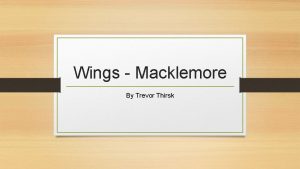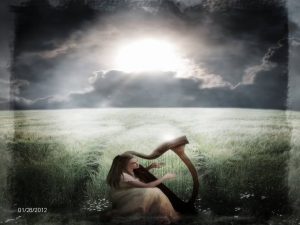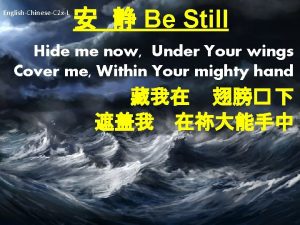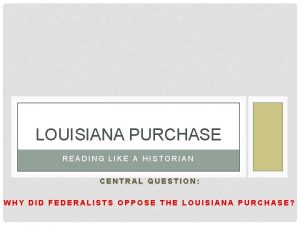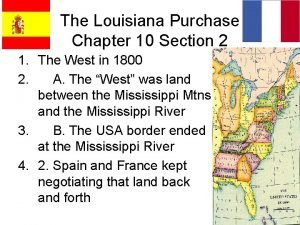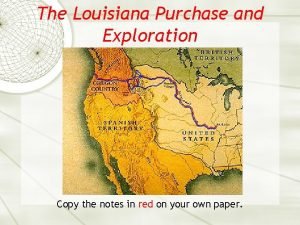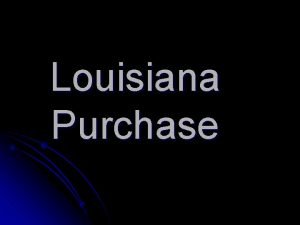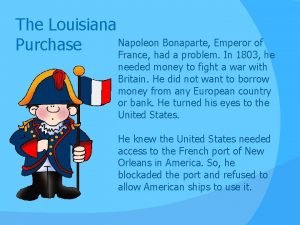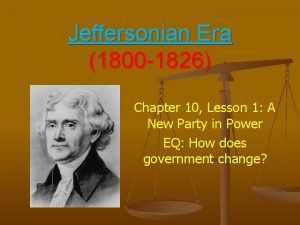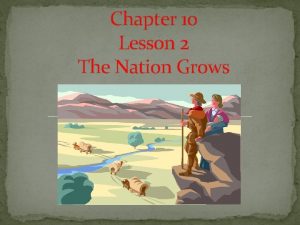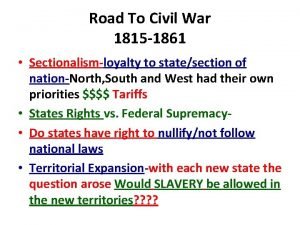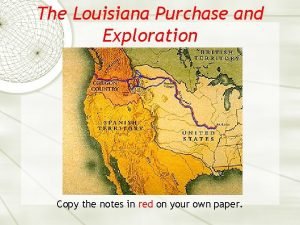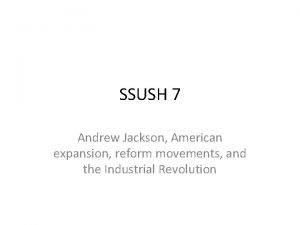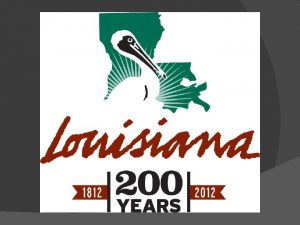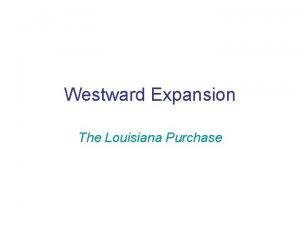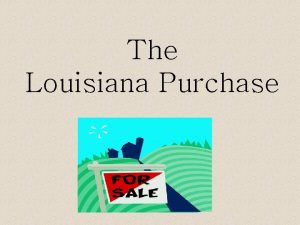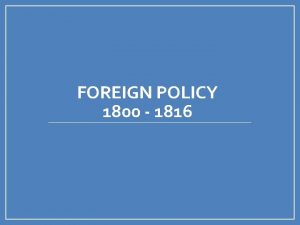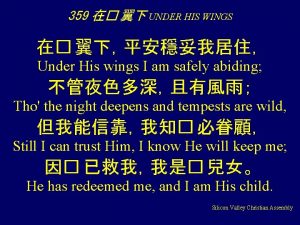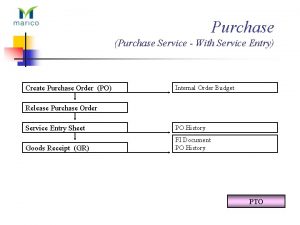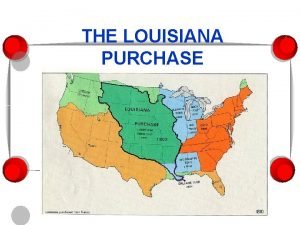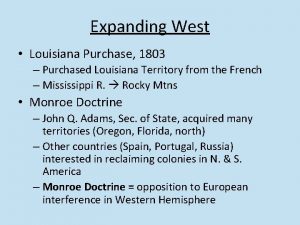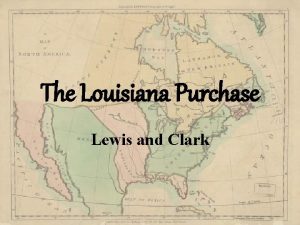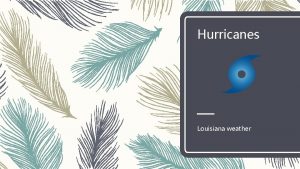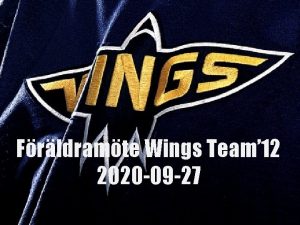The Louisiana Purchase Under My Wings Everything Prospers
















- Slides: 16

The Louisiana Purchase 'Under My Wings, Everything Prospers. ' View of the city of New Orleans, celebrating President Jefferson's Louisana Purchase. The signing of the purchase by Marquis Francois de Barbe-Marbois, Robert Livingston, and James Monroe in Paris, 30 April 1803. Chapter 11 Section 2 1

Spanish - New Orleans • By 1800 western farmers relied on the Mississippi River to ship wheat, pork, apples, corn, and other products. (1) Spain controlled the lower Mississippi which caused problems for Americans. • In 1795 President Washington signed the Pinckney Treaty. Spain agreed to let the Americans ship their goods through New Orleans peacefully. Jackson Square, Port of New Orleans

Louisiana Territory • Spanish control continued to cause problems for Americans. Despite treaties, Spain occasionally stopped Americans from using the lower Mississippi River or imposed a tax on goods sent through New Orleans. • 1800 (2) Spain signed a treaty that ceded, or returned the Louisiana Territory and New Orleans to France wants to grow crops for its French islands. • This worried Jefferson because he was afraid Napoleon would try to build an empire in (3) North America. Haiti

Westward Expansion • Jefferson encouraged Westward Expansion more than any other president. • Jefferson tries to buy New Orleans from Napoleon to make sure that American farmers could ship their goods through the port. • Jefferson sent (4) James Monroe to talk to Talleyrand, the French foreign minister.

Haiti - biggest French colony in the Caribbean. • There, enslaved Africans worked on sugar plantations and made the French planters very wealthy. Mounds of raw sugar at a sugar mill warehouse.

French revolution inspires slaves in Haiti to fight for their liberty. • Toussaint L’Ouverture led the revolt. • By 1801 forced nearly all the French forced out of Haiti. • Napoleon sends troops but never regains control of the colony called (5) Saint Domingue. Independence was declared in 1804 setting up the republic of Haiti.

How ‘bout all of Louisiana? • Napoleon’s loss in Haiti caused many problems. He needed money to (6) pay for his wars. He needed the money to pay soldiers and get weapons. • The French sold Louisiana to the Americans in (7) 1803 for (8) 15 million dollars. No one consulted the Native Americans, who lived on these lands, about the purchase of their homeland. This purchase was called the Louisiana Purchase. 'Under My Wings, Everything Prospers. ' View of the city of New Orleans, celebrating President Jefferson's Louisiana Purchase.

Louisiana Purchase

Controversy Over Purchase • The constitution does not specifically give the federal government the power to purchase land. • Many (9) Federalists strongly oppose the Louisiana Purchase.

Thomas Jefferson sent two explorers • (10) Meriwether Lewis and William Clark to explore the land west of the Mississippi with a party of 33 men known as the Corps of Discovery. They began the expedition in (11) St. Louis, Missouri. A year and a half and more than 4, 000 miles later, the expedition reached the Pacific Ocean.

Along the way • A Native American woman, (12) Sacajawea offered to guide the explorers across the mountains. She also became a translator for the different Native American groups. Lakota Some Common Phrases. . . He táku hwo? What is that? Nitúktetanhan hwo? Where are you from? Tuktétanhan yaú hwo? Where do you come from?

Sacajawea • Sacajawea contributed greatly to the expedition. She gathered wild vegetables and advised the men where to hunt and fish. • As the expedition crossed the Rocky Mountains they had crossed the continental divide.

The Continental Divide is the line that divides the flow of water between the Pacific Ocean and Atlantic Ocean.

Pacific Ocean • The expedition came down the Columbia River and reached the Pacific Ocean in (13) 1805 and spent the winter in the Oregon Country. • The expedition strengthened the United States claim to the (14) Oregon Country.

Before Lewis and Clarke return home • Meanwhile, explorer (15) Zebulon Pike explored the upper Mississippi river, the Arkansas River, parts of present day Colorado, and New Mexico. • During his expedition to Colorado in 1806 -1807, Pike spotted the tall mountain now known as Pikes Peak.

Burr Conspiracy • In 1804, Aaron Burr ran for governor of New York. (16) Hamilton campaigned against him criticizing his integrity and moral values. • Burr challenged Hamilton to a dual and on July 11, 1804. At the signal, Burr fired and struck Hamilton mortally wounding him. Hamilton died the next day and Burr became a political outcast.
 Genesee park to othello
Genesee park to othello Louisiana purchase vocabulary
Louisiana purchase vocabulary God prospers us
God prospers us Cover me under your wings
Cover me under your wings I will be still know you are god
I will be still know you are god Louisiana purchase graphic organizer answer key
Louisiana purchase graphic organizer answer key The louisiana purchase grade 10, 1200l
The louisiana purchase grade 10, 1200l Louisiana purchase notes
Louisiana purchase notes Pros and cons of the louisiana purchase
Pros and cons of the louisiana purchase Apush thesis example
Apush thesis example Louisiana purchase
Louisiana purchase Napoleon louisiana purchase
Napoleon louisiana purchase Chapter 10 lesson 2 the louisiana purchase
Chapter 10 lesson 2 the louisiana purchase Chapter 10 lesson 2 the louisiana purchase
Chapter 10 lesson 2 the louisiana purchase Louisiana purchase flag
Louisiana purchase flag Picture of the louisiana purchase
Picture of the louisiana purchase Louisiana purchase cost
Louisiana purchase cost
